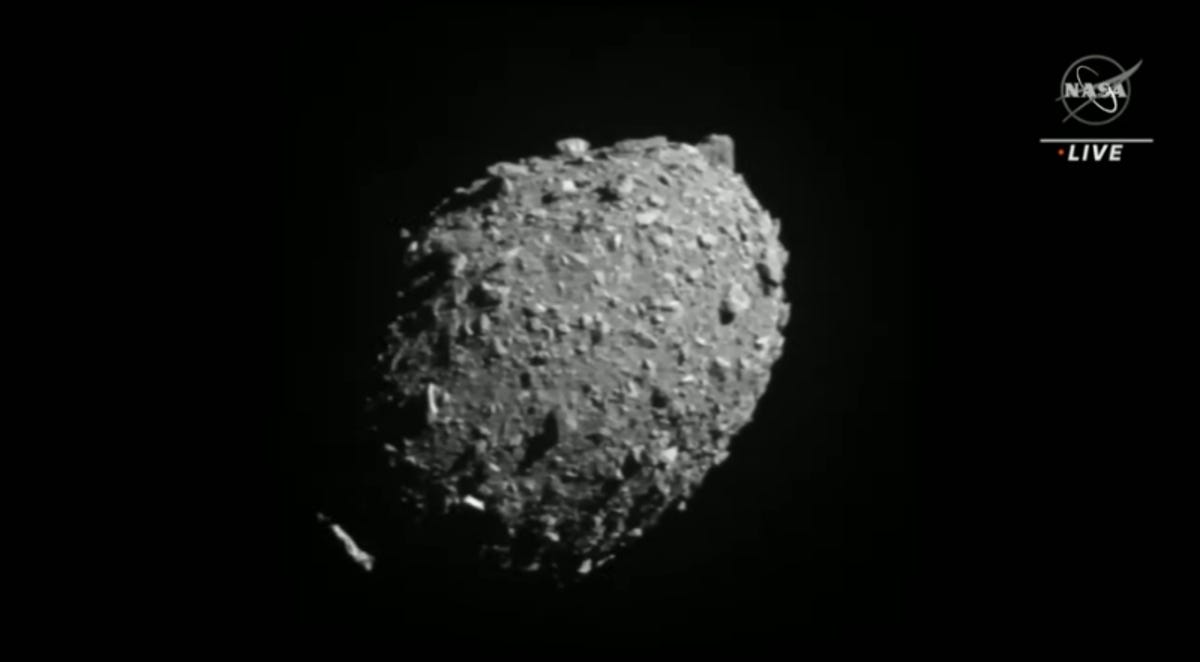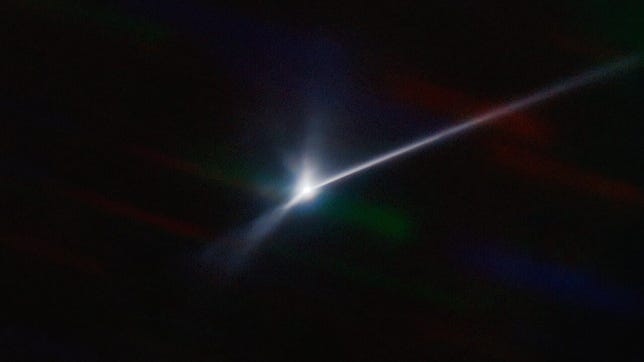NASA DART Mission Might Have Ejected Over 2 Million Pounds of Rock Into Space – CNET [CNET]
The goal was to see whether the impact could alter the orbit of this asteroid, named Dimorphos, around a larger asteroid, named Didymos. To be clear, neither Dimorphos nor Didymos ever posed any threat to our planet. Rather, this was NASA’s proof-of-principle experiment to show us we may have a way to deflect asteroids on a collision course with Earth — should such an issue arrive one day.
And, well, it worked.
After several weeks of post-impact analysis, scientists confirmed that DART officially altered its target’s orbit by 33 minutes. But that wasn’t nearly the end of this little craft’s story. On Thursday, based on early results from the agency’s asteroid defense mission, scientists suggest some other fascinating outcomes of the DART collison.
Most strikingly, they estimate that the crash displaced over 2 million pounds (1 million kilograms) of the asteroid’s dusty rock into space. For context, that’s about enough to fill six or seven railcars, the team says.

What comes next is studying the now free-floating debris to decode what the asteroid might be made of — with novel instruments like the Italian Space Agency’s LICIACube — and connecting the dots to see if such information can shed light on any unresolved matter in our own solar system.
“What we can learn from the DART mission is all part of NASA’s overarching work to understand asteroids and other small bodies in our solar system,” Tom Statler, DART program scientist, said in a statement. “Impacting the asteroid was just the start. Now we use the observations to study what these bodies are made of and how they were formed — as well as how to defend our planet should there ever be an asteroid headed our way.”

In the foreground lies Didymos, the large asteroid that Dimorphos orbits. In the far-ground is Dimorphos and all the rubble that DART’s impact created.
ASI/NASASo far, based on Dimorphos’ ejecta (that’s now bursting outward from the shard in a comet-like tail), the DART team believes both Dimorphos and Didymos have a similar makeup, composed of what are known as chondrites like 85% of all other meteorites we’ve encountered. Meteorites are just asteroids that have made their way to Earth’s surface, so we know what their composition is — and ordinary chondrite space rocks are made of various types of stony substances.
“Studying the ejecta made in the kinetic impact — all of it derived from Dimorphos — is a key way of gaining further insights into the nature of its surface,” Andy Rivkin, DART investigation team co-lead at the Johns Hopkins Applied Physics Lab, said in a statement.
Fascinatingly, scientists also calculated that the momentum transferred between spacecraft and space rock, when DART hit Dimorphos and made the giant dusty mess, was roughly 3.6 times greater than if it was a clean stab — meaning if Dimorphos just absorbed the spacecraft and produced no debris at all.
This is quite cool because that means the ejecta contributed to moving the asteroid more than the literal spacecraft.

The aftermath of DART’s Collision with Dimorphos is the 10,000 kilometer (6,214 mile) long trail of dust captured here by the SOAR Telescope.
CTIO/NOIRLab/SOAR/NSF/AURA/T. Kareta/M. Knight/T.A. Rector/M. Zamani/D. de Martin“Momentum transfer is one of the most important things we can measure, because it is information we would need to develop an impactor mission to divert a threatening asteroid,” Andy Cheng, DART investigation team lead from Johns Hopkins Applied Physics Lab, said in a statement. “Understanding how a spacecraft impact will change an asteroid’s momentum is key to designing a mitigation strategy for a planetary defense scenario.”
Piece by piece, it feels like NASA is entering its Star Wars era.

![nasa-dart-mission-might-have-ejected-over-2-million-pounds-of-rock-into-space-–-cnet-[cnet]](https://i0.wp.com/upmytech.com/wp-content/uploads/2022/12/101961-nasa-dart-mission-might-have-ejected-over-2-million-pounds-of-rock-into-space-cnet-cnet.gif?resize=800%2C445&ssl=1)
![ea-play-2020-–-what-to-expect-from-the-upcoming-not-e3-presentation-[venturebeat]](https://i0.wp.com/upmytech.com/wp-content/uploads/2020/06/2919/ea-play-2020-what-to-expect-from-the-upcoming-not-e3-presentation-venturebeat.jpg?resize=390%2C205&ssl=1)
![mercedes’-big-mbux-update:-here’s-all-the-cool-infotainment-tech-coming-to-the-new-s-class-–-roadshow-[cnet]](https://i0.wp.com/upmytech.com/wp-content/uploads/2020/07/4634/mercedes-big-mbux-update-heres-all-the-cool-infotainment-tech-coming-to-the-new-s-class-roadshow-cnet.jpg?resize=300%2C200&ssl=1)
![best-home-security-cameras-of-2020-that-run-on-batteries-–-cnet-[cnet]](https://i0.wp.com/upmytech.com/wp-content/uploads/2020/10/13177/best-home-security-cameras-of-2020-that-run-on-batteries-cnet-cnet.jpg?resize=300%2C200&ssl=1)